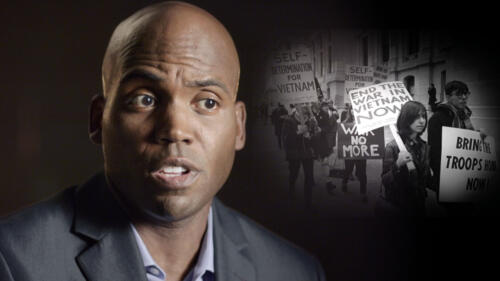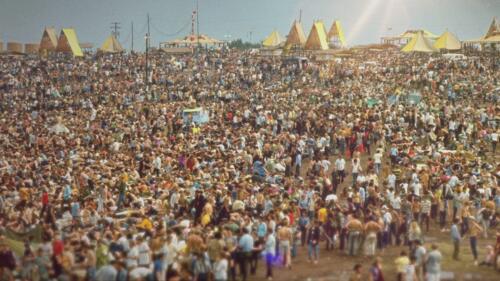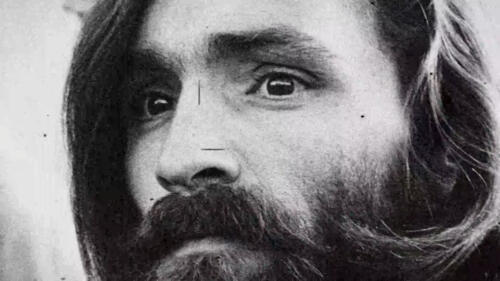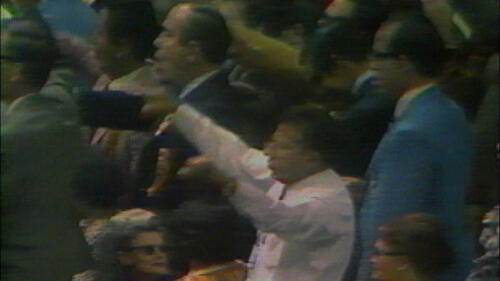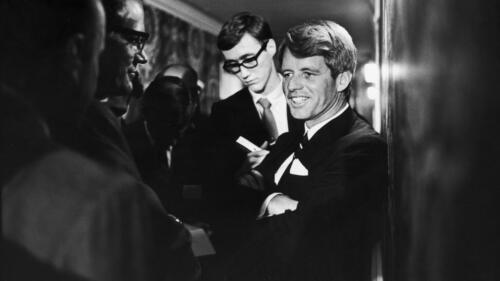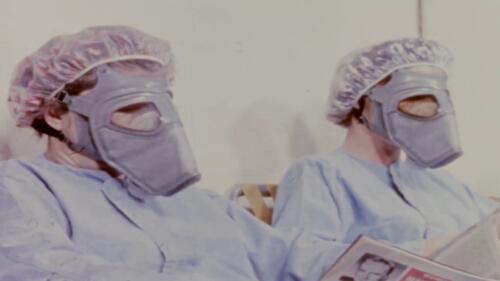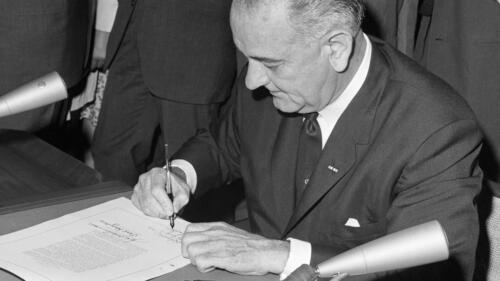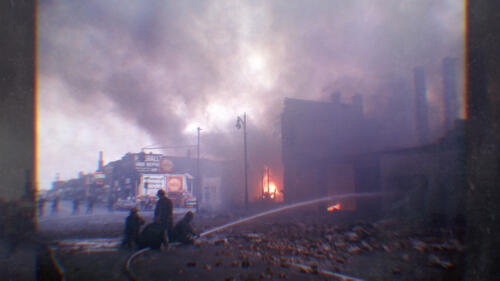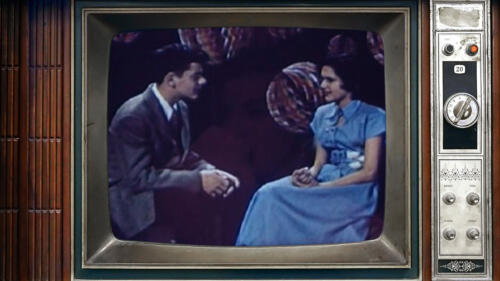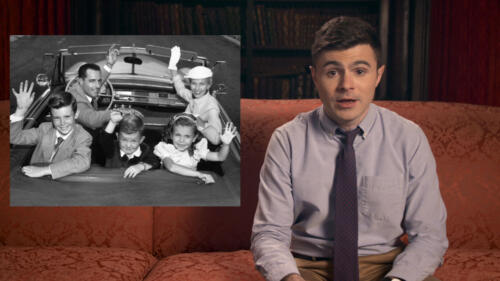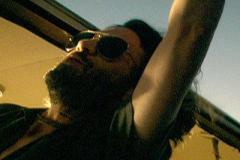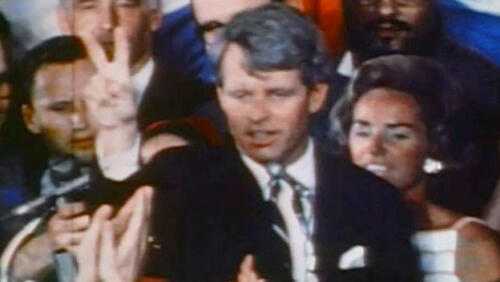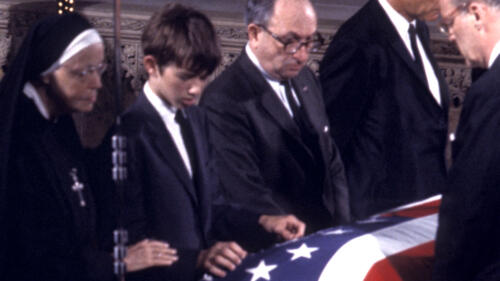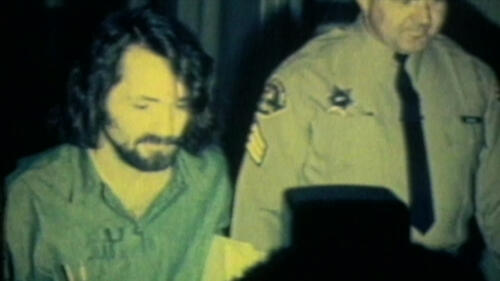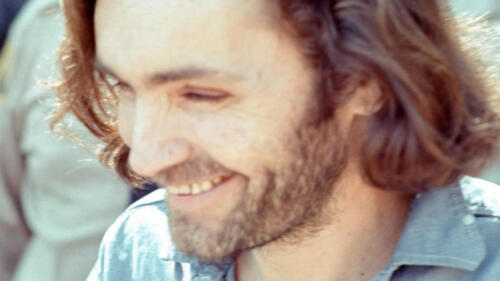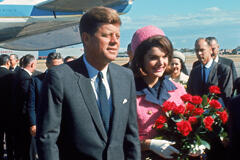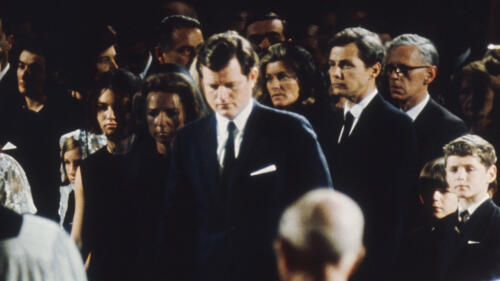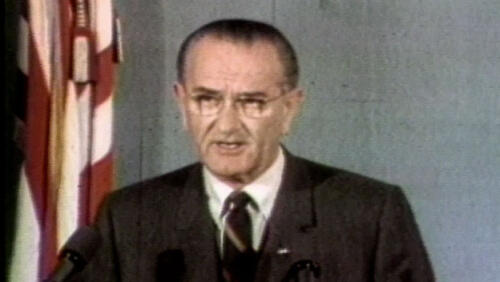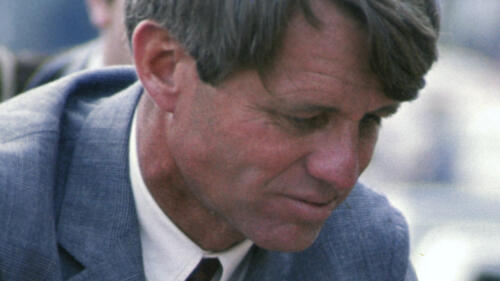1960s
The 1960s marked one of the most tumultuous and divisive decades in world history. The era saw an energized civil rights movement, the Vietnam War and antiwar protests, countercultural movements, political assassinations and the emerging "generation gap."

Start Here

War. Assassinations. Riots. Violent protest clashes. America was certainly no stranger to political violence, but 1968 appeared to bring the bloodletting to new heights.

Explore facts about the 1963 JFK assassination, the perpetrator, investigations...and conspiracy theories surrounding the event.

The Woodstock music festival may not have been a smoothly run event, but it featured electric moments—musical and otherwise—that made it unforgettable.

The hippie counterculture reached its height during the escalation of U.S. involvement in Vietnam, and subsided as the conflict drew to a close.
The Great Society
The Great Society
What did President Lyndon B. Johnson envision with his suite of domestic programs known as the Great Society? What did the programs entail, and what became of them after the 1960s?
3 Major Assassinations of the 1960s
Explore All Related Topics

Behind the modern fairground of turkey legs and jousting knights is a 1960s vision of counterculture.

Flag burning has long tested the limits of freedom of speech.

The competition between the two bands led to some of the most forward-looking and influential music of all time.

The pop sound of The Beach Boys blended Brian Wilson’s musical ambitions with the Californian dream.

As a first-grader, her image became an emotional symbol for civil rights and educational equality.

The 1965 U.S. law requiring health warnings on cigarette packs played a key role in bringing about a new era of tobacco regulation.

The entire U.S. figure skating team was lost in the horrifying crash. But a memorial fund later helped lay the groundwork for recovery.

Explore facts about the 1963 JFK assassination, the perpetrator, investigations...and conspiracy theories surrounding the event.

Presidential historian Doris Kearns Goodwin shares intimate—and harrowing—memories of the turmoil she and her husband witnessed that summer in Chicago.

With youthful stints in the Kennedy and Johnson administrations, the presidential historian and her husband had unparalleled views into the pivotal people and events of that momentous decade.

Martin Luther King Jr.'s wife and child were inside when his home was bombed on January 30, 1956. Thankfully neither were harmed.

In 1967, several prominent antiwar activists urged MLK to run for president with Dr. Spock as his VP.

Before 1962, citizens in some U.S. states had to pay a tax to vote in federal elections. This is how Congress banned the practice.

Barbie may be the star of the Mattel doll line, but she has had many friends along the way.

The 1968 strike was the longest by college students in American history. It helped usher in profound changes in higher education.

In 1965, the two prominent intellectuals faced off in Cambridge, England over whether the American dream is at the expense of African Americans. Baldwin won.

Creative differences, money problems and a certain band member's girlfriend have all been used to explain the split. But what if the truth was a lot more complicated?

After mounting tensions between Catholic nationalists and Protestant loyalists, particularly in Belfast and Derry, violence broke out in the late 1960s.

Oswald's would-be victim on April 10, 1963, was an ultra-conservative firebrand named Edwin Walker.

During the same summer as the legendary Woodstock music festival, the Harlem concert series featured major African American artists against a backdrop of massive social change.

Bureau director J. Edgar Hoover had made his career fighting the perceived threat of communism.

In what came to be known as the 'long, hot summer,' US cities exploded—more than 150 times—into violent upheaval.

Martin Luther King Jr.’s Poor People’s Campaign took protest to a whole new level in 1968 with a tent city that operated as a town.

The New York-to-Washington train had 21 cars, 700 passengers—and millions of trackside mourners.

After sprinters Tommie Smith and John Carlos made a defiant gesture from the awards podium at the Games, they faced repercussions—but also gained respect.

And of course, all that grass inspired innovations in mowing.

Details around the 1969 police shooting of Hampton and other Black Panther members took decades to come to light.

Israel banned 'Goldfinger' for two months after learning about Gert Fröbe’s former Nazi membership.

Despite a landslide loss, the Arizona Republican ignited his party's ultra-conservative wing for decades to come.

When JFK faced a tight race for the White House in 1960, he turned to a group of Americans who had long been overlooked by political campaigns.

It took just four years to get the mumps vaccine ready for market—but its development leaned heavily on groundwork that had been established during World War II.

In one of the worst riots in US history, some 43 people lost their lives and thousands more were injured or arrested.

From post-war recessions to the energy crisis to the dot-com and housing bubbles, some slumps have proven more lasting—and punishing—than others.

Aldrin saw a broken-off circuit breaker switch lying on the floor of the lunar module and "gulped hard."

The queen and the royal family faced significant milestones and challenges during the two decades.

"I am not the Catholic candidate for president,” JFK declared in 1960. “I am the Democratic Party's candidate for president, who happens also to be a Catholic."

1960s television executives weren’t ready to put a blended family on air.

The trial raised questions about the First Amendment and exposed a culture clash in America.

New evidence supports a theory that the pioneering U.N. secretary general was assassinated.

The Woodstock music festival may not have been a smoothly run event, but it featured electric moments—musical and otherwise—that made it unforgettable.

The former Western movie set provided shelter—and isolation—as Charles Manson and his followers plotted the 1969 murders of actress Sharon Tate and others.

When Neil Armstrong stepped down a ladder and onto the moon on July 20, 1969, the nation achieved an audacious vision. But there were surprising moments along the way and not everything went as expected.

Yes, there was rocket science. But there were also extraordinary amounts of low-tech weaving, stitching and caulking.

The 1969 mission was so ambitious it took three presidents to see it through.

NASA created simulations that mimicked everything from the moon’s gravity to its landscape.

In 1969, NASA was spending millions on the Apollo space program. Some argued that money could be better spent.

Neil Armstrong’s celebrated “one small step” was far from the most dangerous maneuver in the effort to send three men to the moon and return them home a week later. See a timeline of the entire mission.

Woodstock 1969 was plagued by stormy weather and technical problems, but it produced a string of musical performances that resonate a half-century later.

Paul McCartney said the song was about a playground slide, but Manson claimed the music incited a race war and murder.

Among seven Apollo moon landing missions, only one did not land men on the moon.

Claims the Apollo 11 mission was staged began soon after astronauts first set foot on the moon in 1969.

The mission that paved the way for the Apollo 11 moon landing came close to ending in disaster.

More than fifty years later, people are still trying to match the bizarre accident that was Woodstock ‘69.

When Cleveland's Cuyahoga River burned, the nation noticed.

To see the epic performances at Woodstock, attendees endured crowds, rain, minimal food and water—and lots of mud.

It took a scandal—and a grand jury investigation—to usher in a more honest era of TV game shows.

Did Stan Lee support the civil rights movement through his comic books for Marvel?

American soldiers returning home from Vietnam often faced scorn as the war they had fought in became increasingly unpopular.

Test pilots, astronauts in training and full astronauts all perished in the effort to lead the space race.

There were arguments over food, helmets and spacesuits that required 30 minutes for astronauts to use the bathroom.

The hippie counterculture reached its height during the escalation of U.S. involvement in Vietnam, and subsided as the conflict drew to a close.

Some of the men who walked by would cheer, while others would shout, 'Go back to the Soviet Union, you commie, lesbian, dyke, crazy, witch.'

In all of their different incarnations, the Men in Black usually have one main purpose: to muzzle witnesses of strange, paranormal phenomena.

On July 20, 1969, two American astronauts landed on the moon and became the first humans to walk on the lunar surface. The event marked the culmination of a nearly decade-long intense push to meet a challenge posed by President John F. Kennedy.

The Yippies found their voice by organizing an absurdist counter-convention—including nominating a pig for president.

Nixon came out of retirement and beat out Ronald Reagan and Nelson Rockefeller to win the nomination, and was elected President that November.

Government researchers found one common denominator among those most likely to riot: They had experienced or witnessed an act of police brutality.

Kennedy drew support from lower-income whites and communities of color, from hopeful youth and disenchanted elders. Historians ponder, if he were elected, whether America might be less divided.

As we commemorate the anniversary of his death, here are 10 things you may not know about Robert F. Kennedy.

In the aftermath of his brother’s tragic death, RFK became a fearless champion for the underrepresented.

Despite not being a registered voter, or even a resident of New York, RFK received special permission to run for Senate. He won the race against incumbent Republican Senator Kenneth Keating by 700,000 votes.

Moments after Valerie Solanas entered Andy Warhol’s sixth-floor office at 33 Union Square West on June 3, 1968, carrying two guns and a massive, paranoid grudge, their lives would be changed forever.

Aides reportedly counseled the GOP candidate against appearing on the goofy, left-leaning comedy show. But Nixon went ahead with his "sock it to me" moment.

The Freedom of Information Act, or FOIA, was signed into law in 1966, giving the public the right to access records from any federal executive branch agency.

Mary Evans was just 16 years old when she attended a rally for presidential hopeful, Robert F. Kennedy. The experience changed her life.

The ‘Gym Crow’ controversy became a flashpoint at an already volatile university.

The Orangeburg Massacre, one of the most violent yet least recognized episodes of the civil rights period, unfolded at South Carolina State University in 1968.

War. Assassinations. Riots. Violent protest clashes. America was certainly no stranger to political violence, but 1968 appeared to bring the bloodletting to new heights.

After the assassination, King's family did not trust the findings of the FBI, which had harassed the civil rights leader while he was alive.

Alien insurance. A leopard-proof cage. And a heroin-addicted ape-man. These are just a few of the odd details behind the making of one of history's most revered movies.

Riots broke out in over 100 American cities after King’s murder.

Back in the 1960s, even the NRA supported gun control to disarm the group.

The 1968 Democratic Convention in Chicago, Illinois, was marked by violent protests and party upheaval as Hubert Humphrey clinched the presidential nomination.

The Woodstock Music Festival began on August 15, 1969 in Bethel, New York. Billed as "3 Days of Peace and Music,” the epic event become synonymous with the counterculture movement of the 1960s.

You have to be 21 to buy a handgun at a store, but only 18 to get one at a gun show.

This Isn’t the First Time Conspiracy Theorists Have Accused Student Activists of Being ‘Paid Actors’
Students were targeted during the Civil Rights movement, too.

As simmering political and cultural resentments exploded in 1968, nearly every week produced news of another earth-shattering event.

From the unlikely host city to the first 'Miracle on Ice,' these games were filled with incredible upsets and improbable firsts.

When Tommie Smith and John Carlos raised their fists in protest at the 1968 Summer Games, Australian runner Peter Norman stood by them. It lost him his career.

Marvel's groundbreaking superhero emerged in the 1960s—during the height of the civil rights movement.

Long before MS-13, Bobby Kennedy battled J. Edgar Hoover to take on the Mafia.

More than fifty years later, one of the only reporters allowed inside recalls the iconic concert.

A turbulent 1968 included the Tet Offensive of the Vietnam War, the assassinations of MLK and Robert F. Kennedy and the historic Apollo 8 lunar mission.

Jones helped convict two men nearly 40 years after their crimes.

The iconic genre-bending show is being revived in 2017.

The writer's epic 1966 party helped relaunch Katharine Graham’s social life.

The cult leader and mass murderer got parole hearings until the very end.

The Great Society was an expansive set of programs and legislation launched by President Lyndon B. Johnson to address issues of poverty, crime and inequality.

After JFK's assassination, 87% of Americans believed Oswald was the sole shooter. What happened?

In 1965, a group of sociologists peeked behind the curtains of a Playboy Mansion party. For science!

The Watts Rebellion was a series of riots that stemmed from an August 1965 arrest in a mostly Black Los Angeles neighborhood before subsiding after six days.

The 1967 Detroit Riots were among the most violent and destructive riots in U.S. history. By the time the bloodshed, burning and looting ended after five days, 43 people were dead, 342 injured, nearly 1,400 buildings had been burned and some 7,000 National Guard and U.S. Army troops had been called into service.

A group of whiz kids using a mainframe computer as big as an elevator staged a wild race against time under the streets of the Big Apple.

Led by white supremacists, the bigoted boycott threatened Cash’s popularity in the South.

Get the facts on the iconic album from The Beatles.

Eight surprising facts about one of the United States’ most iconic service programs.

The cult-classic sci-fi series made an enduring cultural impact way beyond the world of television.

Take a look at Barbie's cultural revolution through the decades.

Bob Dylan shocked audiences at the Newport Folk Festival by strapping on an electric guitar and debuting a new rock ’n’ roll sound.

President Nixon prepared a chilling speech in case disaster struck the moon landing.

Check out seven things you may not know about the iconic entertainer.

Take a look back at how the Fab Four conquered American pop culture.

In an excerpt from his new book, author Steven M. Gillon details the final hours of Lee Harvey Oswald's life.

Find out more about this much-maligned investigation into the murder of America’s 35th president.

President John F. Kennedy was just one of a handful of people hit in downtown Dallas on November 22, 1963.

On September 15, 1963, a bomb exploded at a predominantly Black church in Birmingham, Alabama, killing four young girls and setting off nationwide soul-searching.

The iconic 1969 music festival had a lot of unplanned and surprising aspects.

King penned of the civil rights movement's seminal texts while in solitary confinement, initially on the margins of a newspaper.

In 1962, Marilyn Monroe serenaded President Kennedy with a sultry version of "Happy Birthday."

Jack Ruby (1911-1967), a 52-year-old Dallas nightclub operator, stunned America when he shot and killed Lee Harvey Oswald (1939-1963), the accused assassin of President John F. Kennedy, on November 24, 1963. Ruby was sentenced to the death penalty, but died of cancer in prison.

Caroline Kennedy, the eldest child of U.S. President John F. Kennedy, spent her early years in the White House before becoming a lawyer, author and ambassador.

The 1960s saw John F. Kennedy elected to the White House and gains in civil rights before America splintered amid cultural divisions and Vietnam War protests.

Watch a brief video on the hugely influential Baby Boomers — the generation of Americans born during the post-World War II period between 1946 and 1964.

Richard J. Daley was a political boss who served as mayor of Chicago and chair of the Cook County Democratic Party Central Committee for more than two decades.

Vietnam War protests began among antiwar activists and students, then gained prominence in 1965 when the U.S. military began bombing North Vietnam heavily.

The 1963 bombing of the 16th Street Baptist Church in Birmingham, Alabama, killed four young girls but also generated sympathy for the civil rights movement.

Robert Kennedy served as attorney general under President John F. Kennedy and as a U.S. Senator. He was assassinated while campaigning for president in 1968.

Hubert H. Humphrey was known for his oratorical skill and his advocacy for civil rights as a U.S. senator from Minnesoa and vice president to Lyndon B. Johnson.

The Warren Commission, established to investigate President John F. Kennedy's death, concluded that Lee Harvey Oswald was the lone gunman in the assassination.
